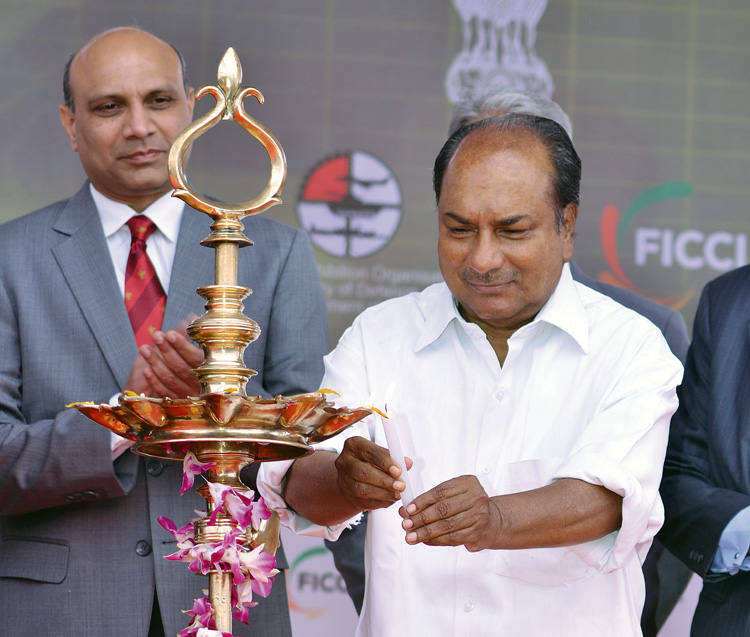- Prime Minister Narendra Modi inaugurates Aero India 2023 in Bengaluru; Releases Commemorative Stamp
- Defence Secretary meets delegations from Saudi Arabia, USA and Oman on the sidelines of Aero India 2023
- Foreign Ministers of 32 countries to attend Aero India 2023
- Embraer showcases the C-390 Millennium at Aero India 2023
Enhance private sector participation, revitalise public sector: Antony

The mantra at the 7th edition of Defexpo India 2012 has been to enhance private sector participation and revitalise the public sector to accelerate defence production in India. The agenda for this was set by the Defence Minister A.K. Antony who inaugurated the biggest Asian event for land, naval and internal security here.
The Defence Minister said Defexpo has recorded unprecedented growth, both in terms of company participation and official delegations. The conference hall was chock-a-block, reflecting the growing interest in the Indian defence market.
Antony emphasised that India had to achieve a high level of indigenisation in defence and ‘this is our thrust area’. “Our emphasis is on public-private sector partnership in the defence industry. Enabling policy framework has been put in place to develop indigenous capabilities through harnessing the potential and utilising resources available, both in the public and the private sector. Our defence industry is now open up to 100 per cent for Indian private sector participation, while foreign direct investment (FD) is permissible up to 26 per cent.”
Greater Transparency and Speed. In line with the industry requirements, review of the Defence Procurement Procedures (DPP) to usher greater transparency and speed in the defence acquisition process is continuously on. “The introduction of ‘Buy & Make (Indian)’ category in DPP is aimed at encouraging proactive participation of the Indian industry by way of forming joint ventures with any foreign manufacturer.”
He said that offset banking was permissible in the Defence Offset policy, the scope of which has now been expanded to include civil aerospace, internal security and training within the ambit of eligible products and services for discharge of offset obligations. The licensing condition has already been rationalised. As part of the continuous process of periodic review of our Defence Procurement Procedure, review of the Defence Offset policy is also being undertaken and further changes are expected in due course.”
Defence Outsourcing Hub. The Indian defence industry, he said, had matured over the years and substantial capabilities have been developed in land, naval and air systems. “As a result of the introduction of Defence Offset policy, India is gradually becoming a key outsourcing hub for the global defence industry.”
Defexpo India 2012, he mentioned, showcased India’s capabilities in land, naval and security systems, as well as its emergence as an attractive destination for investment in defence sector. “The event will also demonstrate our capability to design, develop and deliver a wide range of military and civil products and services to meet the stringent specifications and, that too, at most competitive prices. We are open to enter into mutually beneficial agreements with friendly countries in the field of critical and state-of-the-art futuristic defence technologies. We would welcome all such proposals in our endeavour to modernise our armed forces.”
Antony stated that “at the politico-security level, India has always been recognised as a responsible power and a stabilising factor in this region, in the face of various security challenges originating from different sources around us. India has traditionally been a peace-loving nation. However, we have to be ready to meet any challenge to our territorial integrity and sovereignty. Our armed forces need to have access to the latest defence technologies, equipped with state-ofthe- art platforms, equipment and systems to meet any threat. Our government’s efforts are directed towards modernisation of our armed forces.”
Defence Spend Around 2 per cent of GDP. India’s defence expenditure in the recent past has been around 2 per cent of the GDP, which is consistent with our security needs, as well as our requirements in the area. With the projected annual growth of the Indian economy expected at a trajectory of 8 to 10 per cent for the next two decades, expenditure on defence in absolute terms is bound to increase.
The Minister of State for Defence Dr M.M. Pallam Raju said that the introduction of the new category of acquisition ‘Buy and Make (Indian)’ is a major shift enabling Indian industries to enter into joint ventures with foreign OEMs. The route opened up ways for technology transfer.
Long-term Integrated Perspective Plan (LTIPP) Soon. Dr Pallam Raju said that lack of adequate information regarding the defence requirements has been a major impediment in the growth of the defence industry in India. The government is in the process of finalising the long-term integrated perspective plan (LTIPP) of the armed forces. Consequent to its finalisation, a public version of the document outlining the technology perspective and capability roadmap of the armed forces covering a period of 15 years will be published on the MoD website. This, he added, would enable the domestic industry to plan investment in the defence sector and take up research and development, technology upgradation and forge tie-ups with foreign OEMs.
The Secretary (Defence Production) Shekhar Agarwal, in his welcome address, said that Defexpo was growing progressively from the year 1999 and the number exhibitors this year is 560, up from 412 in 2010. The President of the Federation of Indian Chambers of Commerce and Industry (FICCI), R.V. Kanoria, in his vote of thanks, said that the private sector would rise up to the expectations of the government in building India’s defence industry. The defence sector is a sunrise sector and the private sector would make best use of the opportunities that were opening up.





